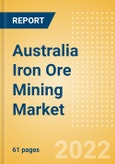The publisher's 'Australia Iron Ore Mining Market by Reserves and Production, Assets and Projects, Fiscal Regime including Taxes and Royalties, Key Players and Forecast, 2021-2026' provides a comprehensive coverage on the Australian iron ore mining industry. It provides historical and forecast data on iron ore production, reserves by country, and world iron ore prices. The report also includes a demand drivers section providing information on factors that are affecting the country's iron ore industry such as demand from end use sectors including steel, construction and automobile industries. It further profiles major iron ore producers, information on the major active, planned and exploration projects.
Australia's iron ore production reached 922.2Mt in 2021, which was up by a marginal 0.4% over the previous year. The flat growth was primarily due to weather disruptions, supply chain delays, maintenance activities, and labor shortages due to COVID-19-related border restrictions. The country's output is expected to reach 931.7Mt in 2022 - up by just 1% compared to the previous year - owing to the development projects that began operations in 2021, such as South Flank, West Angelas, Mesas B, C, and D, and Western Turner Syncline Phase 2, as well as Rio Tinto's Gudai-Darri mine, which commenced operations in June 2022. Production in 2022 will be supported by an expected increase in output from top players, such as Rio Tinto and BHP.
Australia's iron ore production reached 922.2Mt in 2021, which was up by a marginal 0.4% over the previous year. The flat growth was primarily due to weather disruptions, supply chain delays, maintenance activities, and labor shortages due to COVID-19-related border restrictions. The country's output is expected to reach 931.7Mt in 2022 - up by just 1% compared to the previous year - owing to the development projects that began operations in 2021, such as South Flank, West Angelas, Mesas B, C, and D, and Western Turner Syncline Phase 2, as well as Rio Tinto's Gudai-Darri mine, which commenced operations in June 2022. Production in 2022 will be supported by an expected increase in output from top players, such as Rio Tinto and BHP.
Scope
- The report contains an overview of the Australia iron ore mining industry including key demand driving factors affecting the Australia iron ore mining industry. It provides detailed information on reserves, reserves by country, production, competitive landscape, major operating mines, major exploration, and development projects.
Reasons to Buy
- Comprehensive evaluation of the impact of COVID-19 on Australian iron ore industry
- To gain an understanding of the Australian iron ore mining industry, relevant driving factors
- To understand historical and forecast trend on Australian iron ore production
- To identify key players in the Australian iron ore mining industry
- To identify major active, exploration and development projects in Australia
Table of Contents
1. Executive Summary
2. Reserves, Production, and Prices
3. Iron Ore Assets
4. Demand and Exports
5. Major Iron Ore Producers
6. Australia Fiscal Regime
7. Appendix
List of Tables
List of Figures
Companies Mentioned (Partial List)
A selection of companies mentioned in this report includes, but is not limited to:
- Rio Tinto
- BHP
- Fortescue Metals Group
- Mineral Resources Ltd








